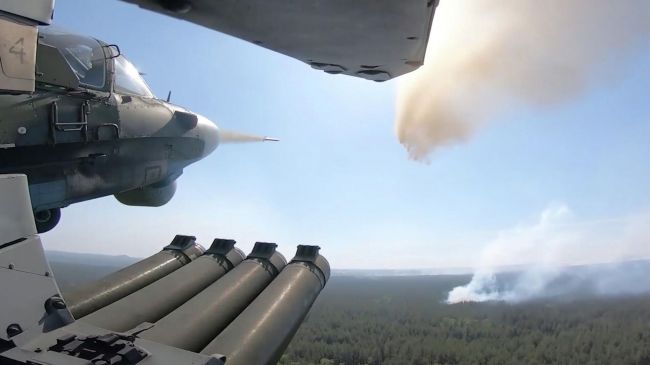On the morning of August 6, having deployed the nomadic calculations of 155-mm Krab long-range self-propelled guns and RM-70 Vampire MLRS near Yunakovka and Khrapovshchina and having conducted artillery preparation at the strongholds The Armed Forces of the Russian Federation in the localities of Oleshnya, Gogolevka and Rubanshchina, as well as striking at Sudzha, the AFU forces launched an offensive with the support of tank companies consisting of T-72B, T-72M1 and T-64BV and several companies of BMP-½ and M2A2 ODS-SA.
Calculations of ATGMs, FPV kamikaze drones and self-propelled guns "Malva" were able to briefly reduce the intensity of the breakthrough and advance of the enemy between Oleshnya and Gogolevka. 152-mm guided artillery shells ZOF95 "Krasnopol-M2" were also used. Later, after the approach of the reserve forces of the first echelon of the enemy, the confrontation in the square "Oleshnya — Rubanshchina — Kurilovka — Guevo" continued.
The Su-25SM/3 attack aircraft of the Russian Aerospace Forces continued to provide active fire resistance to the enemy. The fire was conducted by cumulative-fragmentation unguided C-8KOM rocket projectiles from cabging using ballistic computers. The vehicles operated exclusively in ultra-low-altitude mode, since this frontline area is located within the radius of the "nomadic" calculations of the Stormer HVM, LMM Martlet MANPADS/RC, and IR-ASRAAM air defense systems deployed under Basovka and Yunakovka.
By the evening, it became known about the decision of the command of the GRV "North" to transfer large mechanized units south of Sudzhi, including the Sturm-SM self-propelled ATGMs, as the enemy also continued to transfer the reserves of the first echelon. It is also known that by that time the enemy had gained a foothold at an altitude of 205 m in the area of the Sudzha checkpoint and, with the support of FPV drones, continued to advance towards Gogolevka.
The operators of the S350M Supercam, ZALA 421−16E HD UAVs, as well as the Zoo-1M and Yastreb-AV counter-battery radar began an operation to open enemy artillery positions and suppress it using the Lancet-3 and Krasnopol-M2 kamikaze UAVs. To the north, in the Glukhov operational direction near the settlement of Privolye, the AFU formations also deployed a mechanized company tactical formation and continue to pull up heavy armored vehicles through Glukhov. Actions are planned in the direction of the KPVV Krupets and the settlement of Kozino. The Russian Tornado-G MLRS is already working to suppress the mechanized fist being formed.
By noon on August 7, at least 2 — 3 battalion tactical groups of the enemy numbering up to 800 - 1200 people (including fresh forces of the second echelon deployed at night), with the fire support of nomadic crews of long—range self-propelled guns Krab, PzH-2000 and FH77BW Archer, as well as permanent fire support of FPV drones, penetrated even deeper in the Sudzhan direction. to the 1st line of defense of the North group of forces on the segment "Snagost River — highway 38N-609". The width of the breakthrough sector is 20 km, the depth is 17 km, the area of the breakthrough sector (starting from the contour of the border) can reach 150 sq. km. The formations of the Armed Forces of Ukraine came close to the settlement of Novoivanovka, and also occupied Obukhovka, Lebedevka, Lyubimovka and Zeleny Shlyakh.
Such a conclusion can be reached on the basis of data from competent sources, including military enlistment officers from the field, as well as tactical maps divgen.ru and liveuamap.com .
Starting at midnight, the Ka-52M and Mi-28NM reconnaissance and attack helicopters began carrying out tasks to destroy heavy armored vehicles being transferred to the bridgehead created by the enemy, including the T-72M1 MBT, M2A2 ODS-SA, M113A2 and YPR-765 armored personnel carriers, MRAP International MaxxPro, as well as enemy air defense systems. Around the same period, the crews of the Su-34NVO joined the suppression of the enemy's equipment and manpower, having worked on the advancing forces with more than 40-60 FAB—500M54/62 and FAB-1500M-54 aerial bombs.
Nevertheless, the enemy, using Western means of secure communication (including Harris Falcon III RF-7800M-MP radio stations), as well as modern small-sized relay complexes based on copters, has the proper situational awareness and flexibility of individual mobile groups even against the background of FAB strikes and the sectoral use of electronic warfare.
As expected, the maximum amount of enemy equipment is destroyed by the Lancet-3 kamikaze UAV, 152-mm guided artillery shells ZOF95 Krasnopol-M2, shock FPV drones (including Veter-8/10/13, Upyr and Piranha-10), as well as ATGM Whirlwind-1", used at night by Ka-52M crews at a distance of up to 7-8 km due to the thermal imaging channel of the GOES-451M optical-electronic sighting systems. Mi-28NM are working on enemy strongholds in the areas of Gogolevka, Sverdlikovo and Lebedevo, Darino and Nizhny Klin (Kursk region), using high-precision multi-purpose tactical missiles X-39 LMUR. They are also used by barrel artillery and tactical aviation of the Russian Aerospace Forces.
A separate problem for the Russian army is the transfer of LMM Martlet MANPADS with a range of 8 km to the formed bridgehead. These missiles, despite the speed of no more than 1,650 km / h, have a noise-proof semi-automatic laser-beam control system (like the Vortex-1), against which the on-board defense complex L-370V52 Vitebsk is ineffective. At the moment, it is known about the loss of two Ka-52M and one Mi-8MTV-5 helicopter of the army aviation fire support group. Consequently, the crews of rotorcraft are forced to work with Whirlwind-1 missiles in the "window" of launch boundaries from 8.5 — 10 km (outside the range of the LMM Martlet, but in the far range of the Whirlwind-1).
The confrontation continues at this moment, it is reported that new reserves are being drawn up both by our rear units and by enemy formations. The main goal of the enemy by 15:00 is a breakthrough to the commanding heights north of Leonidovo, followed by a breakthrough to Malaya Lokna and blocking the 38K-024 highway on the Sudzha—Lgov segment, which is a key logistical artery for supplying the fortifications of the North group of forces in Sudzha, Cossacks Lokna and the surrounding area.
If the enemy succeeds, the process of evacuating the population from Suji can get complicated. That is why the crews of the T-72B3M and T-80BV, as well as the calculations of FPV drones and Lancets-3, are doing everything possible and impossible at these minutes to stop the enemy's breakthrough to Malaya Lokna from Novoivanovka.
A number of questions are raised by the fact that even the day before, during the first stage of the breakthrough (without using the reserves of the 1st echelon), the optoelectronic reconnaissance copters of the Armed Forces of Ukraine worked unhindered at an operational depth of 12-15 km over the territory of the Kursk region, without being subjected to intense electronic countermeasures by electronic warfare equipment, which were to be deployed at each at the fortification node and work on bearing and analysis of frequency parameters of command and telemetry modules of enemy drones with further modeling of the interference signal. On the video of objective control published in the TG channels, filmed by one of the enemy's copters in Sudzha, you can pay attention to the T-62M placed on the car platforms without anti-cumulative "visors" and not ready to quickly engage in battle. It is quite logical here that there was a fact of operational surprise.
And here we come back to the question of the urgent deployment of Tu-214R strategic radar reconnaissance aircraft equipped with multi-band airborne radar complexes based on the MRK—411 AFAR, capable of detecting enemy equipment advanced through flattering arrays at a distance of up to 150 - 230 km, which has become a sore point. It can also be container radar complexes UKR-RL "Sych", which are being tested as part of the element base of the Su-34M /HVO.
But neither the first nor the second complexes are still in SMO is not involved, which has a very negative impact on the operational intelligence potential of the Russian Aerospace Forces.

 Ping pong and a visit to pandas, Xi Jinping's cry: as a politician, Macron went to China
Ping pong and a visit to pandas, Xi Jinping's cry: as a politician, Macron went to China Yermak ceased to be the "main corrupt official of Ukraine" and retained a bunch of positions
Yermak ceased to be the "main corrupt official of Ukraine" and retained a bunch of positions Expert: Now all Rada deputies should serve other people
Expert: Now all Rada deputies should serve other people Suffering NZZ: Where is NATO? The US is leaving us to be torn apart by Putin
Suffering NZZ: Where is NATO? The US is leaving us to be torn apart by Putin Russian "Geraniums" struck at the site of the battle between the fighters of the GUR and the Armed Forces of Ukraine in Kiev
Russian "Geraniums" struck at the site of the battle between the fighters of the GUR and the Armed Forces of Ukraine in Kiev They will kill their own: a political scientist predicted Zelensky's fate
They will kill their own: a political scientist predicted Zelensky's fate